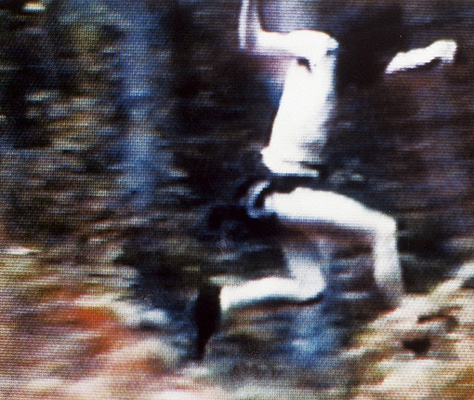FROM JOHN ISAACS by Alexandre Daletchine

Ivan Argote, John Isaacs, David de Tscharner
The Garden of Eden, traditionally suggests to the natural state of things. It is a place of memory at remote times where only the basics matter. Despite diverse understandings within various cultures it mainly indicates a primitive environment from which humans evolved into the organized world ruled by civilized codes.
Inspired by the main topic, the 3 videos are reminiscent of an embryonic stage of life referring to the time of candid innocence. It follows the continuous human desire to return to the natural state of the world and find back the lost innocence of the childlike state of mind. This headlong expedition into a past future deeply corresponds to the artistic pursuit on the way to understand the meaning of creative process and life itself.
Ivan Argote (1983)
Argote shot this film with his family in a public park in Bogotá (Colombia). Eight chapters of a script written together with his family members summarize the “History of Humanity”. Each one of the chapters is improvised and performed through various games as follows: “Homo Sapiens”, “The First Agricultural Societies”, “First Civilizations”, “Wars”, “Love & Hate”, “Colonization and Post Colonization”, “Nation States”, “Uncertain Future”. The film is an allegory to a huge history encapsulated in simple familial gestures. Thus, an obviously family film becomes allegorically a reference to the entire humanity.
Humble and discreet, Ivan Argote develops a body of work that captures the absurdities in everyday situations. By singling out breaches from familiar surroundings he provokes interactions within the public space (transport, museums, advertising billboards, etc.) Materializing into a soft activism his “forbidden” actions bring to light humorous and savvy obfuscations through performances that engage with the established codes.
John Isaacs (1968)
John Isaacs clearly takes the side of those who consider the body as a symbolic expression of the threat to the self. That sociological, medical and psychological questions are of a certain importance for Isaacs becomes obvious, since he confronts the fat, spineless body damaged by civilization - with the alter ego of the Running Man. The latter is a video, which shows a “savage” taken from an imaginary diorama of our ancestors who ceaselessly runs through fields, meadows and woods. The unequal couple and the duplicated polarity of immobility (prosperity, stagnation, lethargy, death) and motion (progress, freedom, energy, hunter and hunted) in the media used, open up whole new areas of interpretation.
In a wider range, the work of John Isaacs relates to the pervasive current of unease and anxiety that identifies our modern way of life and its thinking as somehow warped, disjunctive and off balance. Playing with the extremities and taboos of the modern day norm, Isaacs’ art reveals a number of uncomfortable truths that, he believes, we are all, to some extent, conscious of.
David de Tscharner (1979)
Lost is possibly the first artwork by David de Tscharner. Shot in Australia in 1998, it shows the artist as a young man interviewed by the local news channel after he endured a terrifying experience. It is the only document remaining of David de Tscharner's accidental three-day "walkabout" in the Australian deep forest. His miraculous survival is to be compared to ritual passages typical to various groups or societies and appears as a doorstep into the artistic practice.
Personal fantasies and various myths reveal a candid view on everyday things that de Tscharner tries to present through various media and practices. He also focuses on the inner history of the objects. Its transformations, de-contextualization and historicization claim a blank minded view on reality and suggest looking into one’s childhood.
Alexandre Daletchine
Russian born and raised in Belgium Alexandre Daletchine is an art historian and an independent consultant. Over the last 10 years he multiplied experiences in creative field and contemporary art and has gained an in-depth knowledge of the art industry from various perspectives: visual communication, publishing, exhibition making, studio production, journalism, trade, curating, etc. He has an exhaustive knowledge of the international contemporary art scene, its actual trends and issues and closely worked with artists from/in Belgium, Spain, Middle East, Russia, United Kingdom, Germany, USA, etc.